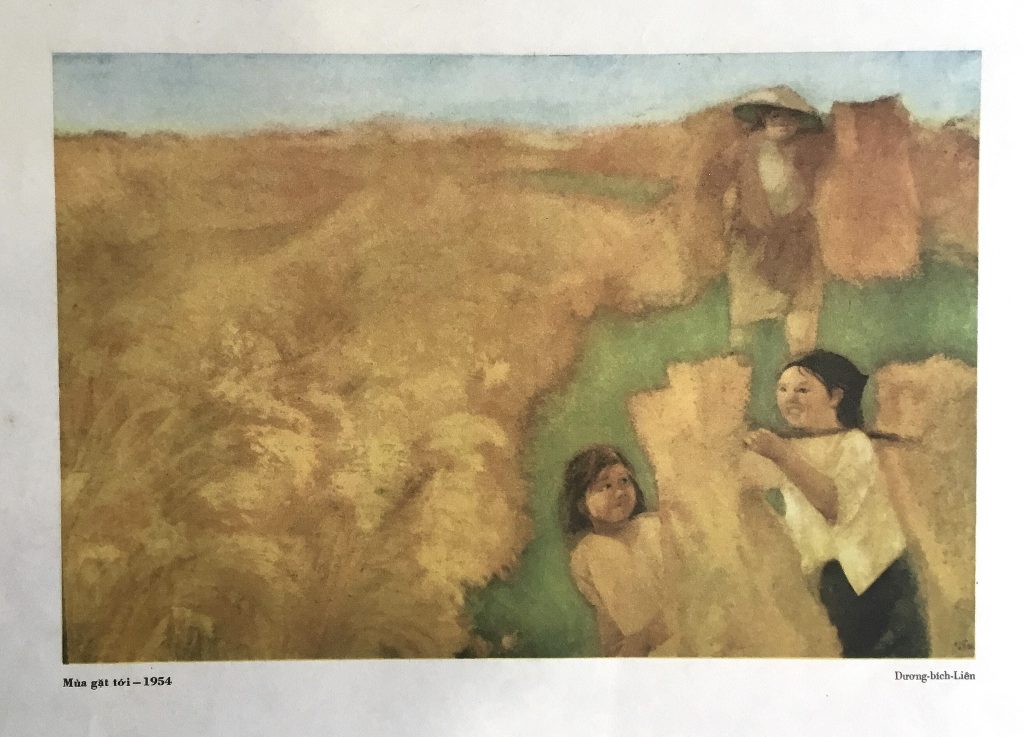According to a document we have kept, at the first and only exhibition of Trong Kiem with the title “Painting exhibition of artist Nguyen Trong Kiem” organized by Vietnam Visual Artists Association and Vietnam Industrial Fine Art University from 7th to 25th February 1987; total paintings of exhibition is 96, all of oil, included about 30 landscapes. In 30 landscapes, there were 9 paintings titled “Mountain scene” were numbered 1 to 9, not in order of time. These nine paintings were painted from 1982 to 1984. If we follow the created year – 1983 and the dimension 60×80 cm, then this painting introduced here perhaps was one of the “Mountain scene” numbered 3 to 6. And certainly, it’s characteristic for painting style of Trong Kiem in the last period, that he died in 1991. Number of landscapes in the exhibition means that the artist’s fond of painting about landscape.
In Vietnam modern painting, Trong Kiem is a typical “programed” artist. His art progressed sequentially from romantic realism to a new symbolic and decorative style of realism, deeply with his personality, and always romantic. His paintings are immediately recognizable “by Trong Kiem” by just one glimpse, almost totally isolated from all sources of influence which he has diligently researched, consulted, studied and transformed into an independent value with Vietnam feature which can only be found in a rare amount of truly talented painters.
Trong Kiem’s paintings, especially paintings in the post-1970 period, it is easy to figure out the principle of combining symbols and decoration has a long tradition in Asian art. However, it is notable that most modern Vietnam artists return to this Eastern tradition through the synthesis and transformation of that tradition by modern Western painters, especially through the works of some of the post-Impressionist masters such as Van Gogh, Gauguin, or the Nabis, where Western painters expressed fervent admiration, the new, fresh inspiration with 17th century Japanese woodblock prints and Asian calligraphy art. Especially since the exhibition of carved versions of communal houses and pagodas organized by Vietnam Fine Arts Museum in 1972, awareness of the value of national art, Vietnam – Asia, through the principle of “decoration and symbolism” more and more understood and imbued by Vietnamese painters and sculptors. They continued to dig to the depth, looking for simple visual representations, diagrams, graphics, regain the ultimate dominance of array and stroke in aesthetic relationship through movement and rhythm, forming new shaping rules as the foundation for unity and generality. The promotion of primitive intellectual abilities seems to be only for “convenience” to carve, more and more confirmed as the ultimate goal of art.

As a painter working in the “industrial art” environment, Trong Kiem especially has the advantage of geometrical structure and the ability to signify. He soon created for himself a separate, purposeful “shape – color – space” set, from which he could present all objects, subjects, all aspects of society. Basically, his art is the process of finding and innovating in oil material, as a means for him to relate, reference and closely follow the trends of modern Western art.
It seems like, every decade (50, 60, 70, 80 of the last century), his painting had new variations and feature, finally, serenely draw the viewer’s eyes to the familiar and at the same time strange patches of colors, streaks, and spots, half-real, half-unreal, awakening and moving viewer with the beauty of perception and imagination above all. The special format here comes from inside, the result of the inner look through the lens of the artist’s soul, full of expression, vivid and natural, far different from “theatre backdrops” that we meet in some other modernist painters.
Due to common practice in the world, especially in our country’s conditions and circumstances, the hope of a retrospective exhibition with the general nature of Trong Kiem’s painting is very fragile. But it is still lucky because many of his works are still preserved in the country. Particularly at Vietnam Fine Arts Museum, he is one of the few artists with the most works. A complete and comprehensive assessment of Trong Kiem’s art and his contributions to Vietnam modern art certainly, still needs to be continued through many elaborate collections, surveys and studies. Any work, any artifact left by him is precious documents, worthy of respect and the presence of the painting “Mountain Scene” here will surely get a lot of interest from researchers and viewers.
Lecturer at Hanoi Industrial Fine Arts University (from 1955 to 1991)
Worked in: watercolor, ink, silk, lacquer, oil
Subjects: revolution, revolutionary war, daily life, social life, landscape, portrait, Giong Saint…
2001 Nation Prize for Literature and Art.
TRONG KIEM (NGUYEN TRONG KIEM)
Born January 1st, 1934 (possibly 1930)
Died August 29th, 1991
Hometown: Quang Trung commune, An Thi district, Hung Yen province
Graduated from Vietnam Fine Arts University, Resistance Course (1950-1954)
By art critic Quang Viet
Copyright belongs to Viet Art View







